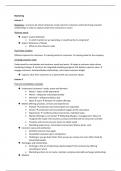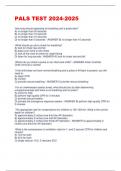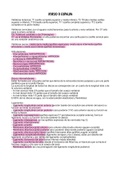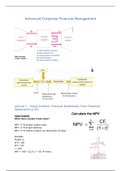Marketing
Lecture 1
Marketing = a process by which companies create value for costumers and built strong costumer
relationships in order to capture value from costumers in return
Relevant needs
➔ Aspect: market definition
• In which market are we operating, or would we like to cooperate?
➔ Aspect: Relevance of Needs
• What are the relevant needs
Dual Value Creation
Different options for costumers → creating value for costumers → creating value for the company
Creating costumer value
Understand the marketplace and costumer needs and wants → design a costumer value-driven
marketing strategy → construct an integrated marketing program that delivers superior value →
engage customers, build profitable relationships, and create customer delight
➔ Capture value from costumers to create profits and costumer equity
Lecture 2
Five core marketplace concepts
➔ Understand customers’ needs, wants and demand
• Needs = states of felt deprivation
• Wants = shaped by culture/personality
• Demands = willing and able to buy
• Need → want → demand → market offerings
➔ Market offering: products, services and experiences
• Product → production and consumption are separated
• Service → production and consumption happen at the same place
• Experiences → combine product and service, individual value
• Market offerings is not market → Marketing Myopia = management’s failure to
recognize the scope of its business, product oriented and not consumer oriented
• Products and services are just means to satisfy needs
• Marketing experiences, not product and services (theme parks, cars)
➔ Costumer value and satisfaction
• Satisfied costumers buy again
• Dissatisfied costumers go to competitors
• Challenges: you go down faster than you go up, reviews are more often made by
dissatisfied people
➔ Exchanges and relationships
• Exchange is the act of obtaining a desired object from someone by offering
something in return
• Marketing actions try to create, maintain, and grow desirable exchange relationships
➔ Markets
, • A market is the set of actual and potential buyers
• Consumers ‘’market’’ when they:
▪ Search for products
▪ Interact with companies to obtain information
▪ Make purchases
▪ Share their experiences
The key elements that guide marketing strategy
Marketing management is the art and science of choosing target markets and building profitable
relationships with them
➔ What costumers will we serve (target market) = ‘’segmentation, targeting, positioning’’
• Example = BMW group
➔ How can we best serve these costumers (value proposition)
• A brand’s value proposition is the set of benefits and values it promises to deliver to
customers to satisfy their needs
Is the marketing the art of selling?
‘’The aim of marketing is to make selling superfluous, the aim of marketing is to know and
understand the customer so well that the product or service fits him and sells itself.’’
Selling and marketing concepts contrasted
The selling concept → inside-out view
➔ Factory → existing products → selling and promoting → profits through sales volume
The marketing concept → outside-in view
➔ Market → customer needs → integrated marketing → profits through customer satisfaction
Societal marketing
The company’s marketing decisions should consider consumer’s wants, the company’s requirements,
consumers’ long-run interests, and society’s long-run interests
Key concepts
➔ Customer relationship management = the overall process of building and maintaining
profitable customer relationships by delivering superior customer value and satisfaction
➔ Relationship building blocks
o Customer-perceived value = the difference between tot customer perceived benefits
and costumer costs
o Customer satisfaction = to extent to which perceived performance matches a buyer’s
ecpextations
➔ Customer-engagement marketing
➔ Consumer-generated marketing
➔ Partner relationship marketing = teaming up with another brand
➔ Costumer lifetime value
➔ Share for customers
➔ Customer equity
➔ Customer relationship groups
, Major trends and forces in the marketing landscape
➔ Digital age (Uber)
➔ Growth of not-for-profit marketing = marketing can help organizations attract membership,
funds and support (goede doelen)
➔ Rapid globalization
➔ Sustainable marketing = companies can do good in the world while still being profitable
➔ Marketing in a ‘’post’’ covid world (picnic)
Lecture 3
Company-wide strategic planning
➔ Strategic planning is the process of developing and maintaining a strategic fit between the
organization’s goals and capabilities, and its changing marketing opportunities
➔ Defining the company mission → setting company objectives and goals (corporate level) →
designing the business portfolio → planning marketing and other functional functional
strategies (business unit, product and market level)
➔ The mission statement = the organization’s purpose; what it wants to accomplish in the
larger environment
➔ Product orientated: ‘’we sell coffee and snacks’’
➔ Market oriented: ‘’to inspire and nurture the human spirit – one person, one cup and one
neighborhood at a time.’’
➔ A mission statement should:
1. Not be myopic in product terms
2. Be meaningful and specific
3. Be motivating
4. Emphasize the company’s strengths
5. Contain specific workable guidelines
6. Not be stated as making sales or profits
➔ How to start?
1. What is our business?
2. Who is the customer?
3. What do consumers value?
4. What should our business be?
Setting company objectives and goals
➔ Business and marketing objectives go hand in hand
➔ Business objectives
1. Build profitbale customer relationships
2. Invest in research
3. Improve profits
➔ Marketing objectives
1. Increase market share
2. Create local partnerships
3. Increase promotion
Lecture 1
Marketing = a process by which companies create value for costumers and built strong costumer
relationships in order to capture value from costumers in return
Relevant needs
➔ Aspect: market definition
• In which market are we operating, or would we like to cooperate?
➔ Aspect: Relevance of Needs
• What are the relevant needs
Dual Value Creation
Different options for costumers → creating value for costumers → creating value for the company
Creating costumer value
Understand the marketplace and costumer needs and wants → design a costumer value-driven
marketing strategy → construct an integrated marketing program that delivers superior value →
engage customers, build profitable relationships, and create customer delight
➔ Capture value from costumers to create profits and costumer equity
Lecture 2
Five core marketplace concepts
➔ Understand customers’ needs, wants and demand
• Needs = states of felt deprivation
• Wants = shaped by culture/personality
• Demands = willing and able to buy
• Need → want → demand → market offerings
➔ Market offering: products, services and experiences
• Product → production and consumption are separated
• Service → production and consumption happen at the same place
• Experiences → combine product and service, individual value
• Market offerings is not market → Marketing Myopia = management’s failure to
recognize the scope of its business, product oriented and not consumer oriented
• Products and services are just means to satisfy needs
• Marketing experiences, not product and services (theme parks, cars)
➔ Costumer value and satisfaction
• Satisfied costumers buy again
• Dissatisfied costumers go to competitors
• Challenges: you go down faster than you go up, reviews are more often made by
dissatisfied people
➔ Exchanges and relationships
• Exchange is the act of obtaining a desired object from someone by offering
something in return
• Marketing actions try to create, maintain, and grow desirable exchange relationships
➔ Markets
, • A market is the set of actual and potential buyers
• Consumers ‘’market’’ when they:
▪ Search for products
▪ Interact with companies to obtain information
▪ Make purchases
▪ Share their experiences
The key elements that guide marketing strategy
Marketing management is the art and science of choosing target markets and building profitable
relationships with them
➔ What costumers will we serve (target market) = ‘’segmentation, targeting, positioning’’
• Example = BMW group
➔ How can we best serve these costumers (value proposition)
• A brand’s value proposition is the set of benefits and values it promises to deliver to
customers to satisfy their needs
Is the marketing the art of selling?
‘’The aim of marketing is to make selling superfluous, the aim of marketing is to know and
understand the customer so well that the product or service fits him and sells itself.’’
Selling and marketing concepts contrasted
The selling concept → inside-out view
➔ Factory → existing products → selling and promoting → profits through sales volume
The marketing concept → outside-in view
➔ Market → customer needs → integrated marketing → profits through customer satisfaction
Societal marketing
The company’s marketing decisions should consider consumer’s wants, the company’s requirements,
consumers’ long-run interests, and society’s long-run interests
Key concepts
➔ Customer relationship management = the overall process of building and maintaining
profitable customer relationships by delivering superior customer value and satisfaction
➔ Relationship building blocks
o Customer-perceived value = the difference between tot customer perceived benefits
and costumer costs
o Customer satisfaction = to extent to which perceived performance matches a buyer’s
ecpextations
➔ Customer-engagement marketing
➔ Consumer-generated marketing
➔ Partner relationship marketing = teaming up with another brand
➔ Costumer lifetime value
➔ Share for customers
➔ Customer equity
➔ Customer relationship groups
, Major trends and forces in the marketing landscape
➔ Digital age (Uber)
➔ Growth of not-for-profit marketing = marketing can help organizations attract membership,
funds and support (goede doelen)
➔ Rapid globalization
➔ Sustainable marketing = companies can do good in the world while still being profitable
➔ Marketing in a ‘’post’’ covid world (picnic)
Lecture 3
Company-wide strategic planning
➔ Strategic planning is the process of developing and maintaining a strategic fit between the
organization’s goals and capabilities, and its changing marketing opportunities
➔ Defining the company mission → setting company objectives and goals (corporate level) →
designing the business portfolio → planning marketing and other functional functional
strategies (business unit, product and market level)
➔ The mission statement = the organization’s purpose; what it wants to accomplish in the
larger environment
➔ Product orientated: ‘’we sell coffee and snacks’’
➔ Market oriented: ‘’to inspire and nurture the human spirit – one person, one cup and one
neighborhood at a time.’’
➔ A mission statement should:
1. Not be myopic in product terms
2. Be meaningful and specific
3. Be motivating
4. Emphasize the company’s strengths
5. Contain specific workable guidelines
6. Not be stated as making sales or profits
➔ How to start?
1. What is our business?
2. Who is the customer?
3. What do consumers value?
4. What should our business be?
Setting company objectives and goals
➔ Business and marketing objectives go hand in hand
➔ Business objectives
1. Build profitbale customer relationships
2. Invest in research
3. Improve profits
➔ Marketing objectives
1. Increase market share
2. Create local partnerships
3. Increase promotion







